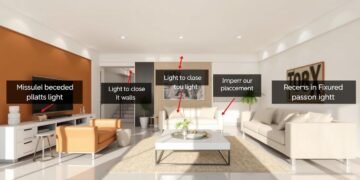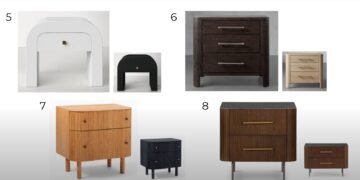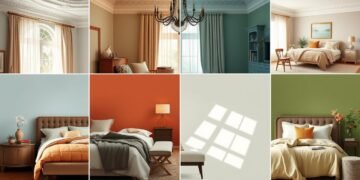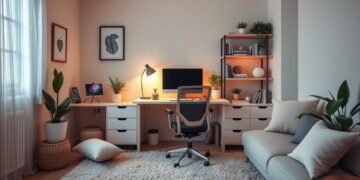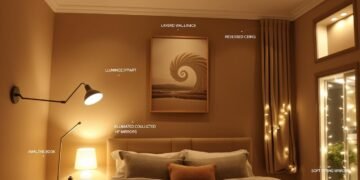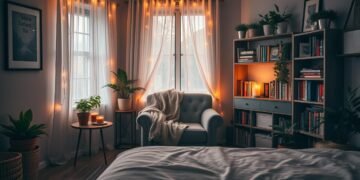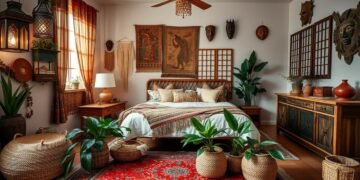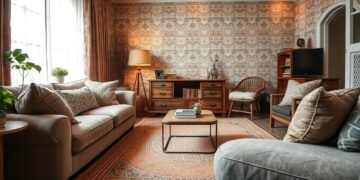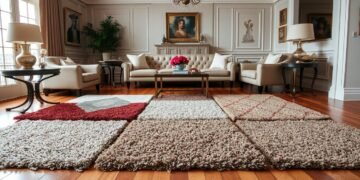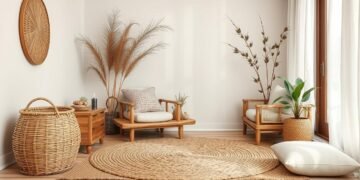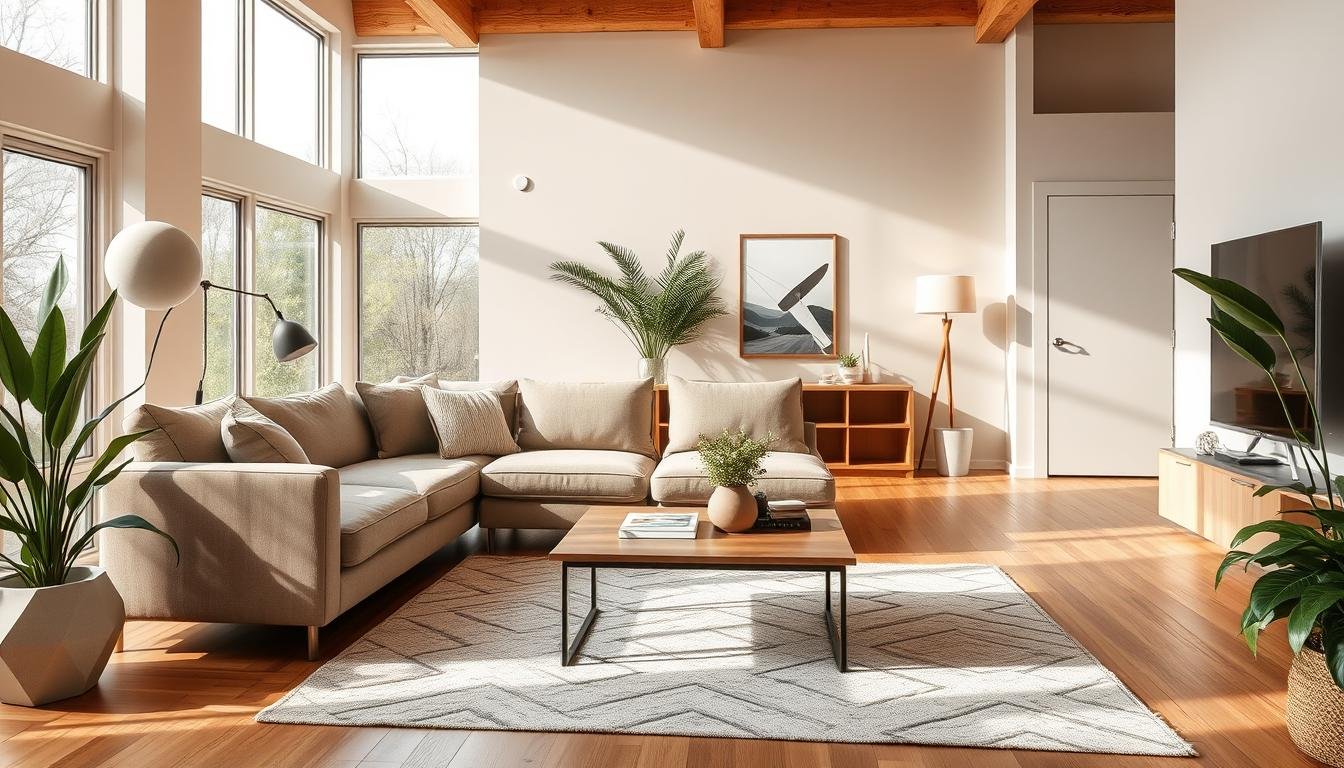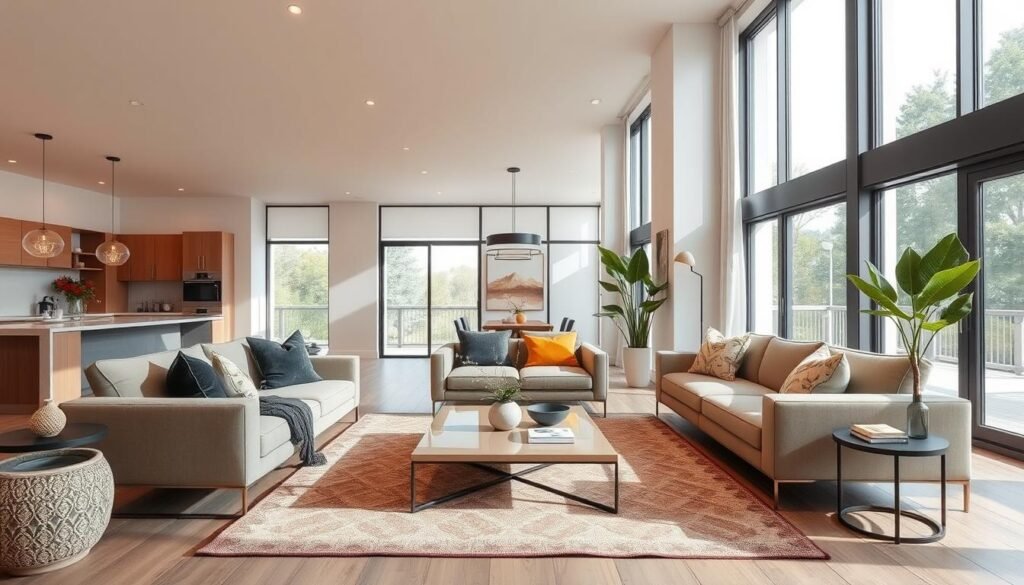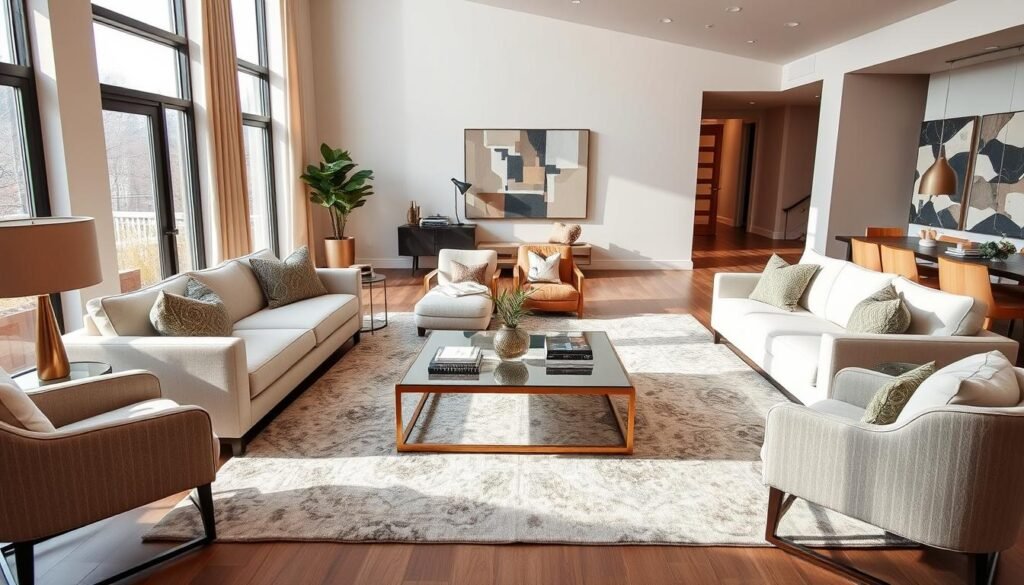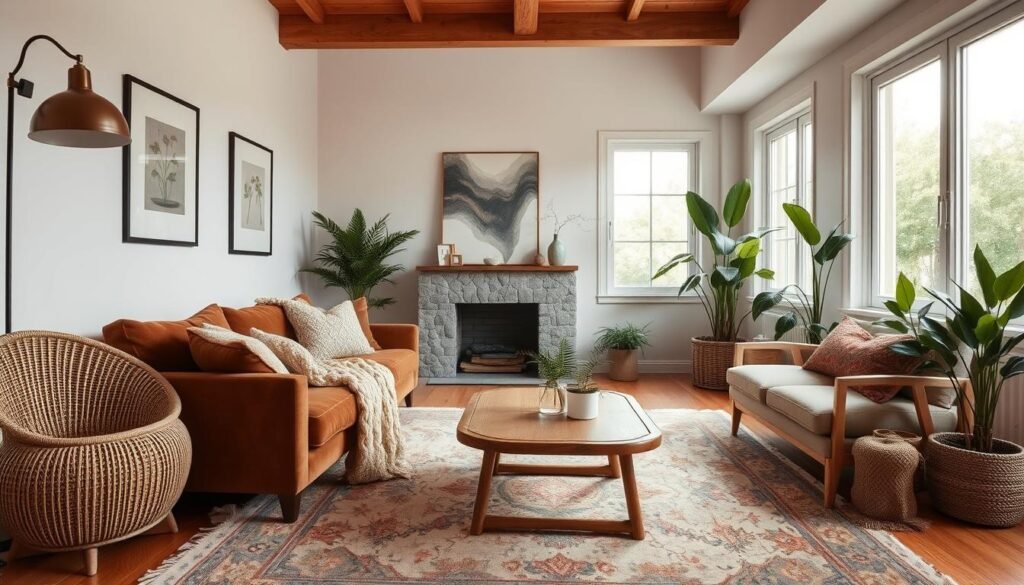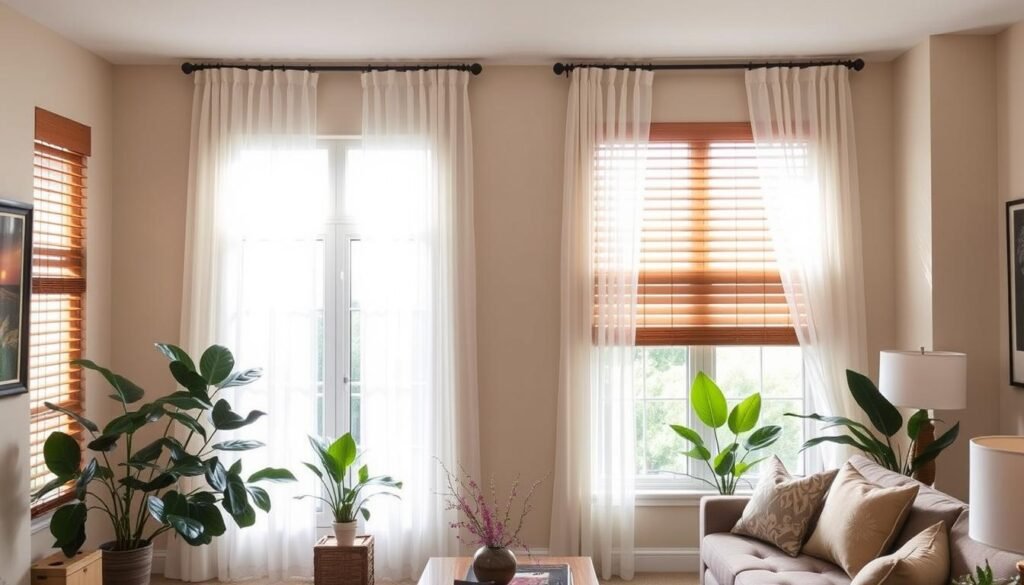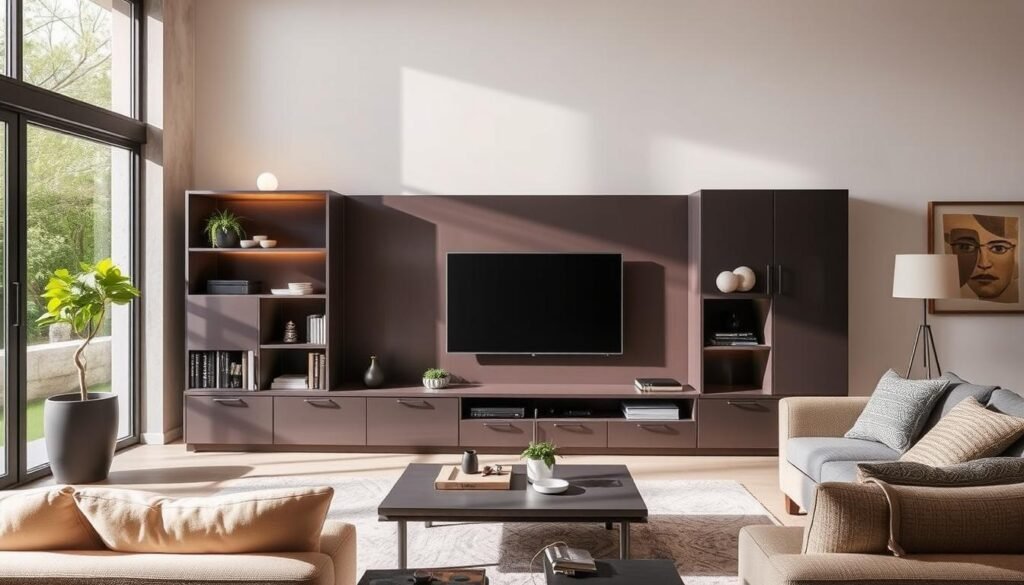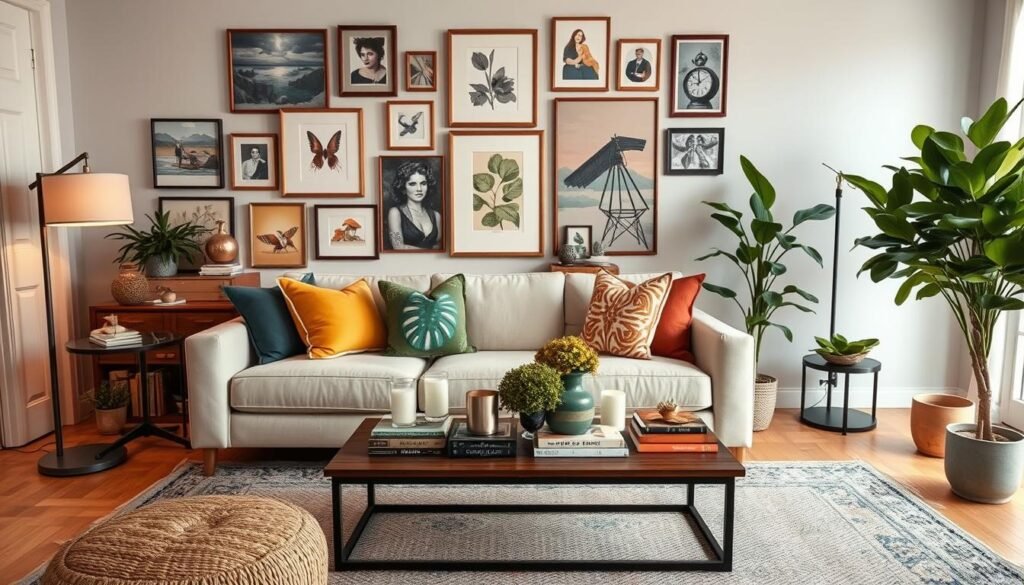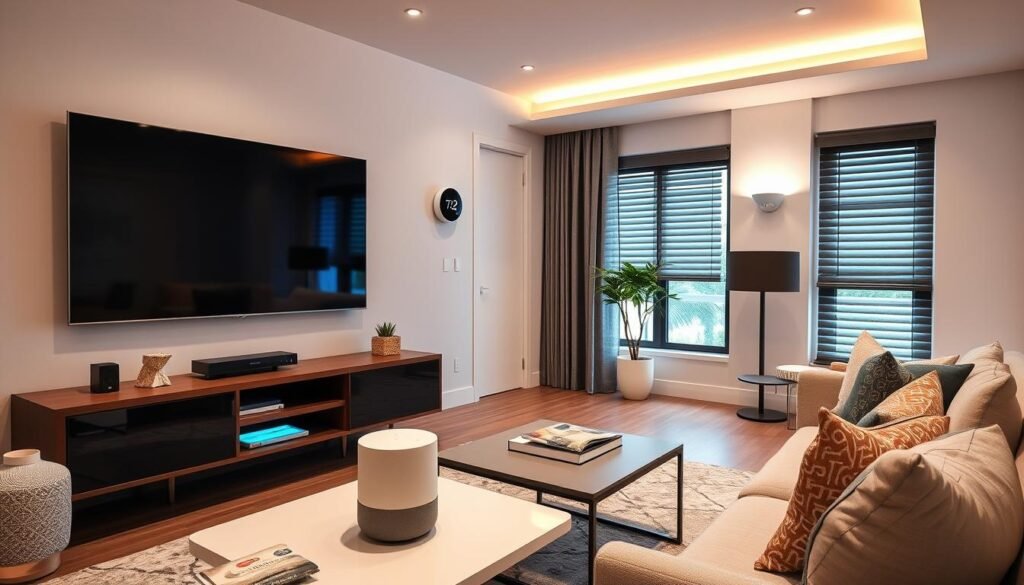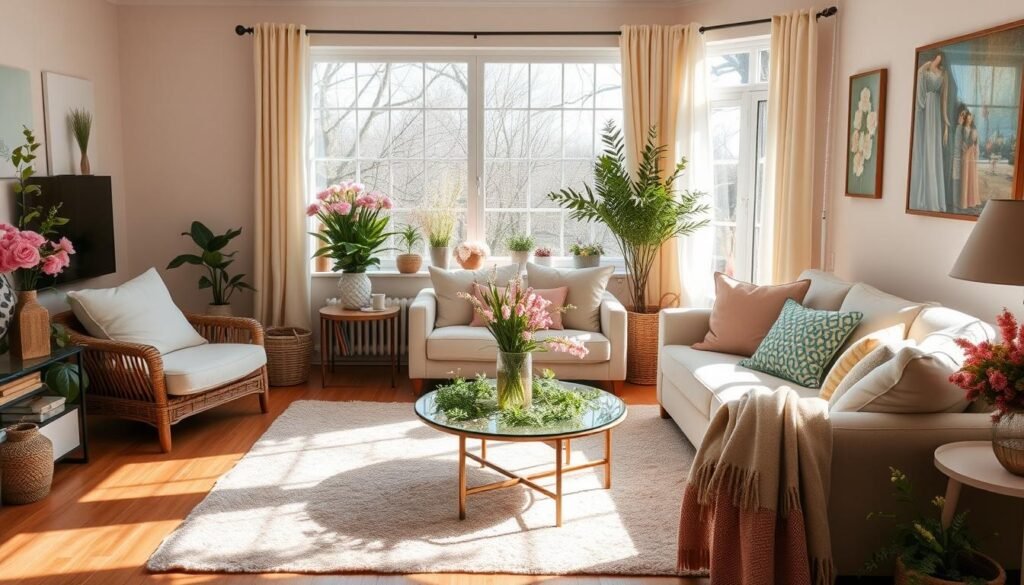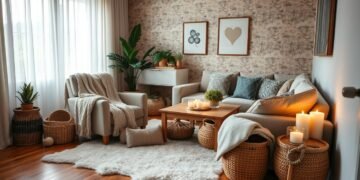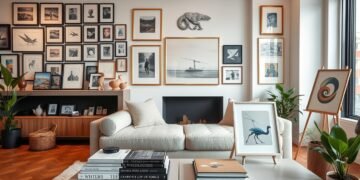Did you know that 60% of living room layouts focus on creating a central space for talking and socializing? This is more important than arranging furniture around a TV1. It shows how key thoughtful design is in making our homes places of connection and shared experiences.
Your living room is the heart of your home. It’s where family and friends gather to unwind, chat, and make memories. By learning the art of living room design, you can turn this area into a cozy and stylish spot that shows off your personality and meets your needs.
Good living room design is all about finding the right mix of space planning, furniture, colors, and lighting. With 70% of designs focusing on placing furniture to create different zones, it’s clear that a well-planned layout is essential. It helps separate areas for relaxing, working, playing, and talking1.
As we dive into interior decorating and home decor, we’ll share 12 key tips for a welcoming and useful living room. We’ll cover everything from improving traffic flow to adding personal touches. These tips will help you create a space that’s truly yours.
Whether you’re starting fresh or updating your living room, these tips will spark your creativity. With 25% of layouts placing a main sofa opposite windows for natural light and views, it’s clear that using your room’s best features is key to great design1.
Let’s start this journey to make your living room a stylish and practical place for gatherings. It’s a space that you and your loved ones will love for years.
Key Takeaways
- Focus on creating a central gathering space for social interaction
- Use strategic furniture placement to define distinct zones
- Maximize natural light and outdoor views
- Balance functionality with aesthetics
- Incorporate personal style elements
- Consider traffic flow and space utilization
- Adapt design to suit your unique needs and preferences
Understanding Living Room Design Fundamentals
To make your living room cozy, start with the basics. A good design mixes useful layouts with stylish touches. This ensures your space is both comfy and looks great.
Core Design Principles
Balance, proportion, and harmony are key in living room design. Choosing the right sofa is important, as it sets the layout for other pieces like armchairs and coffee tables2. Use a mood board to plan your space and avoid mistakes3.
Space Assessment Basics
Start by measuring your living room accurately. 85% of experts say this is vital to avoid layout problems2. Think about your room’s layout and how it affects where you place furniture.
Function vs Aesthetics Balance
Finding the right mix of function and style is key. Think about what your living room is for – entertaining, relaxing, or both. Use different lighting types to create a design that works for all activities2.
| Design Element | Functional Aspect | Aesthetic Consideration |
|---|---|---|
| Sofa | Comfortable seating | Style and color coordination |
| Coffee Table | Surface for items | Visual interest and proportion |
| Entertainment Unit | Storage and display | Integration with overall design |
| Lighting | Task and ambient illumination | Mood setting and focal points |
75% of designers suggest using area rugs to tie furniture together and avoid a disjointed look2. By following these tips, you’ll have a living room that’s both useful and beautiful.
Creating an Effective Layout Strategy
A well-planned living room layout is key to a welcoming space. Begin by thinking about your room’s purpose and what activities it will host4.
Traffic Flow Optimization
Ensuring easy movement is vital for a cozy living area. Keep 30-36 inches between big furniture for walkways, and 24 inches in smaller rooms5. This makes the space open and avoids feeling too tight.
Furniture Placement Guidelines
Begin with big items like sofas and dining tables4. Place your sofa two-thirds of the wall length, 3-5 inches from the wall for a better feel5. For chatting areas, keep seats 3-10 feet apart5.
Zoning Different Activities
Make different zones for different activities in your living room. Use area rugs to mark off spaces in open layouts, making sure they fit furniture well5. A sectional can help make cozy reading or talking spots in big rooms.
Remember, balance is important in room layouts. Spread furniture out and try different setups before you decide4. By following these tips, you’ll have a living room that’s both useful and looks great.
Establishing a Focal Point
Your living room needs a focal point. It’s the first thing eyes see when entering the room. A strong focal point anchors your design and gives the space purpose67.
Consider natural elements like fireplaces or large windows. If these aren’t options, create a focal point with a statement piece of furniture or artwork. An accent wall with bold color or unique wallpaper can also serve this purpose7.
When choosing your focal point, keep it at eye level. This creates a seamless connection between the feature and viewers. Aim for one or two focal points to avoid a disjointed feel68.
Frame your focal point with decor. Use chairs, plants, or mirrors to draw attention. This technique guides the eye and enhances the overall design7.
“A well-chosen focal point draws people into a space without them even realizing it.”
Remember, your color scheme plays a key role. Use bold colors or contrasting patterns to make your focal point stand out. Consider how flooring and furniture placement can complement your chosen feature6.
| Focal Point Ideas | Design Impact |
|---|---|
| Fireplace | Creates warmth and coziness |
| Gallery Wall Layout | Adds personality and visual interest |
| Large Window | Brings in natural light and outdoor views |
| Statement Furniture | Defines the room’s style and function |
By establishing a clear focal point, you’ll create a living room that feels purposeful and inviting. It’s the key to a cohesive design that guides visitors through your space effortlessly8.
Choosing the Right Furniture Scale
Choosing furniture that fits your living room’s scale is key to a harmonious space. Let’s look at how to pick the right pieces for your room.
Sofa and Seating Selection
When picking a sofa, think about comfort and size. A good sofa should leave 30″ to 36″ between big pieces to avoid clutter9. For comfort, keep 3.5′ to 10′ between seats9. Don’t push your sofa against the wall; leave 3-5 inches for a more open feel9.
Recliners and ottomans add comfort but check they don’t block paths. In big rooms, you can seat 6-8 people, great for parties10.
Table Dimensions and Proportions
Your coffee table should be half the sofa’s length for scale9. Place it 16″ to 18″ from the sofa for easy access9. Side tables should be no deeper than the sofa and 2-3″ below the arm height for ease9.
| Furniture | Recommended Dimensions | Placement Guide |
|---|---|---|
| Sofa | Varies based on room size | 3-5″ from wall |
| Coffee Table | Half the sofa length | 16-18″ from sofa |
| Side Tables | Not deeper than sofa | 2-3″ below arm height |
Storage Furniture Considerations
Add bookshelves, cabinets, and other storage to use space well. Shelving units can also act as room dividers and display areas. Make sure storage furniture fits your room’s scale and doesn’t overwhelm it.
Creating space plans and measuring before buying helps your room’s function and flow10. By following these tips, you’ll have a stylish and well-proportioned living room.
Color Schemes and Visual Harmony
Creating a harmonious color palette is key for your living room’s design. It’s important to balance colors & finishes that show your style and the room’s purpose. Experts say using 3 to 5 colors is best to avoid feeling too much or too little11.
The 60-30-10 rule is helpful when choosing colors. Use 60% of your main color, 30% of a secondary color, and 10% for an accent. This makes your space balanced and appealing12.
Start by thinking about what’s already in your room. Furniture, flooring, or unique features like a fireplace can guide your color choice11. Neutral tones like white, beige, or grey help balance bold colors12.
Lighting affects how colors look in your space. Natural and artificial light can change color appearance12. Try different finishes like matte vs. glossy to add depth and interest.
“Color is a power which directly influences the soul.” – Wassily Kandinsky
For a cohesive look, use an analogous color scheme. This means choosing three colors next to each other on the color wheel. It works well in living rooms, creating a cozy atmosphere. Soft blues and greens make your space welcoming12.
| Color Scheme | Primary Color | Secondary Color | Accent Color |
|---|---|---|---|
| Warm Analogous | Yellow (60%) | Yellow-Orange (30%) | Orange (10%) |
| Cool Analogous | Blue (60%) | Blue-Green (30%) | Green (10%) |
| Neutral with Pop | Beige (60%) | Gray (30%) | Teal (10%) |
Texture contrast can make your color scheme pop. Mix smooth and rough textures for interest. Whether you choose bold colors or soft pastels, make sure they work together to create a welcoming space.
Lighting Design for Ambiance
Creating the perfect ambiance in your living room starts with thoughtful lighting design. A well-lit space can change the mood and function of your gathering area. Let’s explore how to achieve the best lighting for living rooms.
Natural Light Utilization
Maximize natural light to enhance your living room’s atmosphere. Bright flooring materials, like light-colored hardwood, can reflect sunlight and make the space feel airier13. During evenings, use natural light to complement your artificial lighting for a cozy feel13.
Artificial Lighting Layers
A balanced lighting scheme includes three essential types: ambient, task, and accent lighting13. Ambient lighting sets the overall tone, while task lighting focuses on specific areas for activities like reading or working1314. Accent lighting adds depth and highlights focal points in your living room1314.
Mood Setting Techniques
Smart lighting solutions offer remote control via smartphones or voice commands, allowing you to adjust the ambiance effortlessly15. Install dimmer switches to control brightness and create the perfect atmosphere for any occasion13. Warm-toned light bulbs can instantly elevate your space and create a soothing environment13.
Consider incorporating various light sources like ceiling fixtures, chandeliers, and wall sconces to add visual interest and functionality to your living room14. By blending style and utility in your fixture selection, you can create a harmonious and inviting living space that adapts to diverse functions and atmospheres14.
Incorporating Texture and Materials
Make your living room stand out by mixing different textures and materials. Combine soft fabrics with hard ones like wood or metal for a lively look. Use rugs, window treatments, throw pillows, blankets, and furniture upholstery to add texture16.
Here are some top materials for your living room:
- Wood: Adds warmth and natural beauty
- Leather: Brings sophistication and durability
- Fabric: Offers comfort and variety
- Metal: Provides sleek, modern accents
- Glass: Creates an illusion of space
- Stone: Introduces organic, timeless elements
For a rich texture, mix upholstery materials like leather, velvet, silk, bouclé, wool, cotton, and linen16. This mix adds depth and interest to your space. Use embossed, woven, or graphic wallpaper, plaster, or textured panels on walls for more dimension16.
Textured art is key in your design. It has three types: visual, tactile, and textural contrast17. Visual texture uses shading for illusions, while tactile texture creates layers for touch17. Mixing textures in a piece achieves contrast17.
“Texture is the most enduring and ubiquitous underpinning of form… surely a calming, meditative, and appealing world for both the eye and mind.” – Lynda Lehmann
Choose materials and textures that are both stylish and practical. Aim for a balance to make your living room beautiful and functional.
| Material | Texture | Durability | Maintenance |
|---|---|---|---|
| Wood | Smooth to rough | High | Medium |
| Leather | Smooth | High | Low |
| Fabric | Soft to coarse | Medium | Medium |
| Metal | Smooth to textured | High | Low |
| Glass | Smooth | Medium | Low |
| Stone | Rough to polished | High | Low |
Window Treatment Solutions
Window treatments are key in living room design. They balance privacy, natural light, and style. Choosing curtains or blinds can change a room’s look and feel.
Drapery Selection Guide
When picking curtains, think about fabric weight, pattern, and color. Light fabrics like linens are favored by 80% of designers for a soft look18. Pinch pleats are a classic choice for 65% of designers18.
Interestingly, 45% of designers see a rise in draperies with fancy elements like cornices and tassels18.
Privacy vs Natural Light
Finding the right balance between privacy and natural light is important. Sheers are used by 75% of designers to frame windows and add coziness18. About 60% of designers note clients want automated Roman shades with traditional pleated panels18.
These options let you control light levels and keep privacy.
Style Enhancement Options
Window treatments can greatly enhance your living room’s style. Custom solutions are popular, with 75% tailored to fit specific designs19. About 35% of treatments use curtains with unique colors or patterns to match the room’s design19.
For drama, 5% of treatments use floor-length curtains to make rooms seem taller19.
| Window Treatment Type | Designer Preference | Key Benefit |
|---|---|---|
| Light Linen Curtains | 80% | Soft, Airy Look |
| Pinch Pleat Curtains | 65% | Classic, Tailored Appearance |
| Automated Roman Shades | 60% | Light Control & Privacy |
| Inset-mounted Woven Shades | 50% | Texture Without Distraction |
Your window treatments should match your ceiling design and room decor. By picking curtains or blinds that fit your space, you can make a welcoming living room.
Storage and Organization Systems
A clutter-free living room is essential for a relaxing space. Smart storage solutions can help achieve this goal while adding style. Let’s look at some clever ways to keep your living area organized and functional.
TV units with storage are a big help for living rooms. These pieces hold your TV and offer space for books, media, and decor. Built-in shelving is a favorite, found in 25% of living space storage solutions20. They use vertical space well, keeping your floor open and welcoming.
Hidden storage furniture is also great for a tidy living room. Ottomans with secret spots or side tables with drawers can hide blankets, remotes, and more. About 10% of storage tips focus on these versatile pieces20. They’re ideal for small spaces or rooms with many uses.
Experts say to tidy up your living room monthly21. This habit stops clutter from building up and keeps your space’s purpose clear. Begin with drawers and shelves to set up a system21. Assign each item a home to prevent mess later.
For affordable storage, watch for sales. Some stores offer up to 30% off storage cabinets, TV units, and bookcases during sales22. These deals can help you find stylish, functional furniture without breaking the bank.
The secret to a well-organized living room is finding a balance between function and beauty. By using smart storage and keeping up with organizing, you can make a space that looks good and works well.
Accessorizing with Purpose
Make your living room stand out by learning how to accessorize. The right decor can boost your room’s look and make it feel welcoming.
Art and Wall Decor
Choose artwork and wall decor that match your room’s colors and style. Big pieces can be eye-catching, while a gallery wall adds flair. Pick navy blue or lavender for your art to follow the latest trends23.
Decorative Objects Placement
Place decorative items with care to avoid clutter. Use the rule of three for items on shelves or tables. Adding indoor plants brings life to your room. Choose smaller coffee tables for a more practical look23.
Personal Touch Elements
Add your personal touch with special accessories. Show off family photos, souvenirs, or collections to share your story. Use plush cushions and rugs for texture and warmth. Mirrors can make a room look bigger, perfect for small spaces24.
For rooms that serve many purposes, add floating shelves and bookshelves. They offer storage and help create different moods in your space24. In homes with kids, stylish storage like sideboards and ottomans keep play areas neat without losing style25.
By accessorizing your living room wisely, you can make it both beautiful and personal. Aim for a balance between looks and function to keep your room welcoming and useful.
Technology Integration
Step into the future of living room design by mixing smart home devices and home theater systems. The smart home trend is growing fast. Homeowners use tech to control things like lighting and temperature26. Choose sleek, minimalist tech that fits your design vision for a space that looks good and works well27.
Keeping your space clean is key. Use cable concealers or furniture with built-in cable management to hide wires27. Wireless tech, like charging pads and speakers, also cuts down on clutter and makes your room look better27.
Hide tech in your decor with smart solutions. Try TV mirrors, hidden charging stations in furniture, and concealed speakers27. These ideas let you enjoy smart home devices without losing your room’s style.
| Smart Device | Integration Method | Benefit |
|---|---|---|
| Smart Lighting | Recessed or hidden cove lighting | Set mood, energy efficiency |
| Voice Assistants | Discreet placement or built into furniture | Hands-free control of smart devices |
| Smart Thermostats | Wall-mounted in a central location | Energy savings, comfort optimization |
| Home Theater System | In-wall speakers, hidden projector | Immersive entertainment experience |
Add voice activation and smart home automation for easy tech control27. This lets you manage lighting, temperature, and entertainment with voice commands. It makes your living experience better28.
Integrate tech wisely in your living room design for a stylish, smart, and efficient space. Welcome the future of interior design with these tech-savvy solutions that meet both style and function needs.
Sustainable Design Practices
Choosing sustainable living room design is more than a trend; it’s a must. Studies show that interior design can have a bigger carbon footprint than building itself29. This highlights the need for eco-friendly materials and energy-saving lights in our homes.
Eco-friendly Materials
Green building materials like bamboo, reclaimed wood, and recycled glass are key29. They help reduce harm to the environment and add charm to your living room. New materials like mycelium leather and algae-based fabrics are also emerging for upholstery and decor29.
Energy Efficiency
Using energy-efficient lighting is vital in sustainable design. LED lights and smart natural light use can cut down energy use2930. Adding solar panels can also lower your carbon footprint. Good ventilation and non-toxic materials improve air quality, benefiting both the planet and your health30.
Sustainable Furniture Choices
Choose durable furniture to avoid waste29. Vintage or retro pieces offer a unique, eco-friendly style. Minimalist designs are also great for creating stylish, clutter-free spaces while saving resources29.
| Sustainable Design Element | Benefits |
|---|---|
| Recycled Aluminum | Reduces pollution, carbon emissions, and electricity usage30 |
| Natural Light | Improves mood, sleep patterns, and attention span30 |
| Smart Technology | Optimizes energy usage based on occupancy and activities29 |
By using these sustainable practices, you’re not just designing a room; you’re creating a space that cares for the planet and improves your life. Every eco-friendly choice we make helps build a greener future.
Seasonal Adaptability
Your living room makeover doesn’t have to be a one-time affair. Embrace versatile design to keep your space fresh year-round. Seasonal decor allows you to transform your living area effortlessly, reflecting the changing moods of nature.
Start with a neutral base and adjust your color palette seasonally. In spring, introduce pale blush and mossy greens. Summer calls for sunny yellows and sky blues. As autumn arrives, shift to deep reds and burnt oranges. Then, transition to icy grays and pine greens for winter31.
Wall art plays a key role in seasonal adaptability. Rotate between watercolors for spring, bold prints for summer, nostalgic images for fall, and serene photography for winter31. This simple change can dramatically alter your room’s atmosphere.
Adjust your furniture layout to suit the season. Create open spaces for summer gatherings, then cluster seating around a focal point like a fireplace for cozy winter nights31. Adding or removing accent pieces can subtly evolve your room’s look over time, creating a collected feel32.
Incorporate seasonal textures to enhance comfort. Try airy linens in spring, nautical stripes in summer, velvet accents in fall, and faux furs in winter31. Updating pillows and choosing textured linens can significantly alter your living space’s character32.
“A room should never allow the eye to settle in one place. It should smile at you and create fantasy.” – Juan Montoya
Remember, versatile design is about balance. Mix formal and informal elements for a cohesive aesthetic32. By embracing seasonal adaptability, you’ll create a living room that’s always in style, no matter the time of year.
Conclusion
Your living room is the heart of your home. It’s where design and function come together to make a cozy space. By focusing on a good layout, you can turn it into a place for both relaxation and fun33.
Creating a unique living room is all about mixing style with practicality. This balance is key to a successful design.
Getting inspiration from different sources can help you make a space that shows who you are. Add textures, meaningful objects, and mix styles to tell your story33. Lighting, both natural and artificial, also plays a big role in setting the mood and making the room feel right.
When designing your family room, think about what you’ll do there. Set up different areas for reading, talking, and more to make the most of the space33. Also, remember to include storage to keep things tidy and organized. This way, your living room will stay a welcoming place for years.
By following these design tips, you’ll have a living room that looks great and works well for you. Your new space will be a source of pride and happiness, making your home more comfortable and enjoyable.







